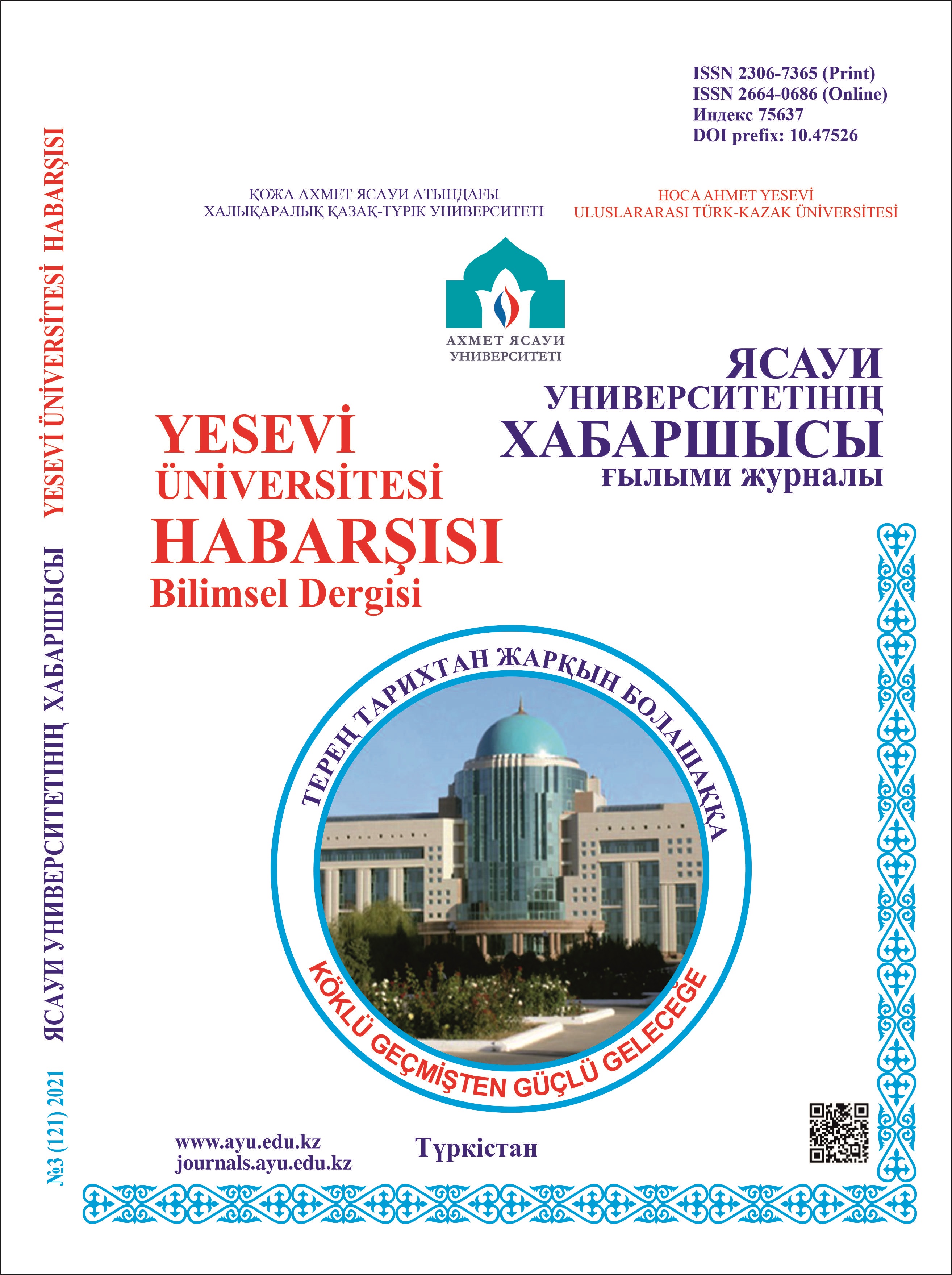G. BELGER’İN “SERGALI ATA” HİKAYESİNDEKİ BAŞLANGIÇ KONUSU: YAPI, SEMBOLLİK VE TARİHSEL-KÜLTÜREL BAĞLAM
194 56
Anahtar Kelimeler:
başlangıç, Gerold Belger, motif, kültürel etkileşim, olgunlaşma, sembolizm, öz farkındalık.Özet
Makale, G.K. Belger’in “Sergali Ata” (1971) öyküsündeki başlangıç olay örgüsünü, anlatının yapısal ve anlamsal çekirdeği olarak ele almaktadır. Bu olay örgüsü, karakterin gelişim sürecini ve kişisel kimliğinin oluşumunu tarihsel ve kültürel dönüşümler bağlamında yansıtır.
Çalışmanın amacı, başlangıç olay örgüsünün yapısal ve anlamsal özelliklerini belirlemek ve kültürel hafızayı ve etnik gruplar arası etkileşimi anlamadaki önemini analiz etmektir. Bu amaca ulaşmak için üç yöntem kullanılmıştır: yapısal analiz (metnin mimarisinin yeniden yapılandırılması ve klasik başlangıç döngüsüyle – “ayrılma - sınama – dönüş” - karşılaştırılması); kültürel yaklaşım (imge ve motiflerin sembolik içeriğinin ortaya çıkarılması); biyografik yöntem (sanatsal unsurların yazarın kişisel deneyimiyle ilişkilendirilmesi). Çalışmanın teorik temeli, evrensel başlangıç modellerine güvenmemizi sağlayan A. van Gennep ve M. Eliade’nin kavramlarıdır. Araştırma konusunun önemi, başlangıç öyküsünün hem edebi bir olgu hem de kişilik gelişimi, kültürlerarası diyalog, tarihsel hafıza ve süreklilik gibi varoluşsal meseleleri anlamanın bir yolu olması gerçeğiyle belirlenmiştir.
Çalışmanın bilimsel yeniliği, öykünün ilk kez başlangıç öyküsü bağlamında yorumlanması, bir motifler kompleksinin (kutsama, rehberlik, misafirperverlik ritüelleri, etnografik işaretler) tanımlanması, bunların “yedi ata” geleneğiyle karşılaştırılması ve kültürel adaptasyonu temsil etmedeki rollerinin ortaya konulmasıdır. Analiz sonucunda, kahramanın kişisel deneyiminin kolektif hafıza kalıplarıyla bağlantılı olduğu ve başlangıç öyküsünün kişisel gelişim çerçevesinin ötesine geçerek kültürlerarası diyalog ve yeni bir sosyokültürel gerçekliğe giriş için bir metafor haline geldiği kanıtlanmıştır. Çalışmanın sonuçları, G. Belger’in nesrinin sanatsal dünyasının özelliklerini açıklığa kavuşturmakta, Kazak geleneğinin etnografik ve kültürel kodlarıyla bağlantısını belirlemekte ve sürgün ve kültürel entegrasyon deneyiminin sanatsal yorumunda başlangıç olayının önemini doğrulamaktadır. Çalışmanın pratik değeri, sonuçların edebiyat, kültürlerarası iletişim ve kültürel bellek çalışmaları derslerinde kullanılma olanağıdır.
Referanslar
СПИСОК ИСПОЛЬЗОВАННОЙ ЛИТЕРАТУРЫ
Бельгер Г. Избранные сочинения: в 10 т. – Т. 1. – Алматы: Балалар әдебиеті, 2012. – 326 с.
Геннеп А.В. Обряды перехода. – М.: Наука, 1999. – 198 с.
Элиаде М. Тайные общества. Обряды инициации и посвящения. – СПб.: Университетская книга, 1999. – 356 с.
Бельгер Г. Автобиография. [Электронный ресурс]. URL: https://adebiportal.kz/kz/authors/view/1466 (дата обращения 18.12.2024)
Мифологический словарь / гл. ред. Е.М. Мелетинский. – М.: Советская энциклопедия, 1990. – 672 с.
Холлис Дж. Под тенью Сатурна: мужские психические травмы и их исцеление. – М.: Когито-Центр, 2009. – 211 с.
Худзиньска-Паркосадзе А. Парадигма инициации в сказке «Василиса Прекрасная» // Вестник славянских культур. – 2019. – Т. 51. – С. 99–115.
Осмонова Н.И. Имя как миф и символ человека традиционного общества кочевников // Народы и религии Евразии. – 2010. – №4 (4). – С. 215–222.
Випулис И.В. Инициация в художественной культуре: современные подходы к исследованию // Вестник Московского государственного университета культуры и искусств. – 2022. – №4 (108). – С. 65–70. http://doi.org/10.24412/1997–0803-2022-4108-65-70.
Алимбай Н. Семипоколенная экзогамная структура «Жетіата» как община-социум (к проблеме совпадения рода и общины у казахов-кочевников) // Turkic Studies Journal. – 2021. – Т. 2, №4. – С. 7–26. http://doi.org/10.32523/2664–5157-2020-2-4-7–26.
Свитенко Н.В. Метасюжет инициации в современной отечественной прозе для подростков // Известия ВГПУ. Филологические науки. – 2022. – №6 (169). – С. 226–229.
Сарсамбекова А.С., Баязитова Р.Р., Ботбайбеков С.К., Ибадуллаева З.О., Ярыгин С.А. «Бата беру» в культуре казахов – традиции и новации // Вестник НГУ. Серия: История, филология. – 2021. – Т. 20, №3. – С. 131–141. http://doi.org/10.25205/1818–7919-2021-20-3-131-141
REFERENCES
Belger G. Izbrannye sochinenia: v 10 t. T. 1 [Selected works: in 10 volumes. Vol. 1]. – Almaty: Balalar adebietі, 2012. – 326 s. [in Russian] 2. Gennep A.V. Obriady perehoda [Rites of Passage]. – M.: Nauka, 1999. – 198 s. [in Russian] 3. Eliade M. Tainye obshestva. Obriady iniciacii i posviashenia [Secret societies. Initiation and initiation rites]. – SPb.: Universitetskaia kniga, 1999. – 356 s. [in Russian] 4. Belger G. Avtobiografia [An autobiography]. [Electronic resource]. URL: https://adebiportal.kz/kz/authors/view/1466 (date of access 18.12.2024) [in Russian] 5. Mifologicheski slovar [The Mythological Dictionary] / gl. red. E.M. Meletinski. – M.: Sovetskaia enciklopedia, 1990. – 672 s. [in Russian] 6. Hollis Dj. Pod teniu Saturna: muzhskie psihicheskie travmy i ih iscelenie [Under the Shadow of Saturn: Male mental injuries and their healing]. – M.: Kogito-Centr, 2009. – 211 s. [in Russian] 7. Hudzin'ska-Parkosadze A. Paradigma iniciacii v skazke «Vasilisa Prekrasnaia» [The paradigm of initiation in the fairy tale “Vasilisa the Beautiful”] // Vestnik slavianskih kultur. – 2019. – T. 51. – S. 99–115. [in Russian] 8. Osmonova N.I. Imia kak mif i simvol cheloveka tradicionnogo obshestva kochevnikov [Имя как миф и символ человека традиционного общества кочевников] // Narody i religii Evrazii. – 2010. – №4 (4). – S. 215–222. [in Russian] 9. Vipulis I.V. Iniciacia v hudozhestvennoi kulture: sovremennye podhody k issledovaniu [Initiation into art culture: modern approaches to research] // Vestnik Moskovskogo gosudarstvennogo universiteta kultury i iskusstv. – 2022. – №4 (108). – S. 65–70. http://doi.org/10.24412/1997–0803-2022-4108-65-70. [in Russian] 10. Alimbai N. Semipokolennaia ekzogamnaia struktura «Zhetіata» kak obshina-socium (k probleme sovpadenia roda i obshiny u kazahov-kochevnikov) [The seven-generational exogamous structure of the “Zhetiata” as a community-society (on the problem of the coincidence of clan and community among Kazakh nomads)] // Turkic Studies Journal. – 2021. – T. 2, №4. – S. 7–26. http://doi.org/10.32523/2664–5157-2020-2-4-7–26. [in Russian] 11. Svitenko N.V. Metasiuzhet iniciacii v sovremennoi otechestvennoi proze dlia podrostkov [The meta-plot of initiation in modern Russian prose for teenagers] // Izvestia VGPU. Filologicheskie nauki. – 2022. – №6 (169). – S. 226–229. [in Russian] 12. Sarsambekova A.S., Baiazitova R.R., Botbaibekov S.K., Ibadullaeva Z.O., Iarygin S.A. «Bata beru» v kulture kazahov – tradicii i novacii [“Bata Beru” in Kazakh culture – traditions and innovations] // Vestnik NGU. Seria: Istoria, filologia. – 2021. – T. 20, №3. – S. 131–141. http://doi.org/10.25205/1818–7919-2021-20-3-131-141[in Russian]

